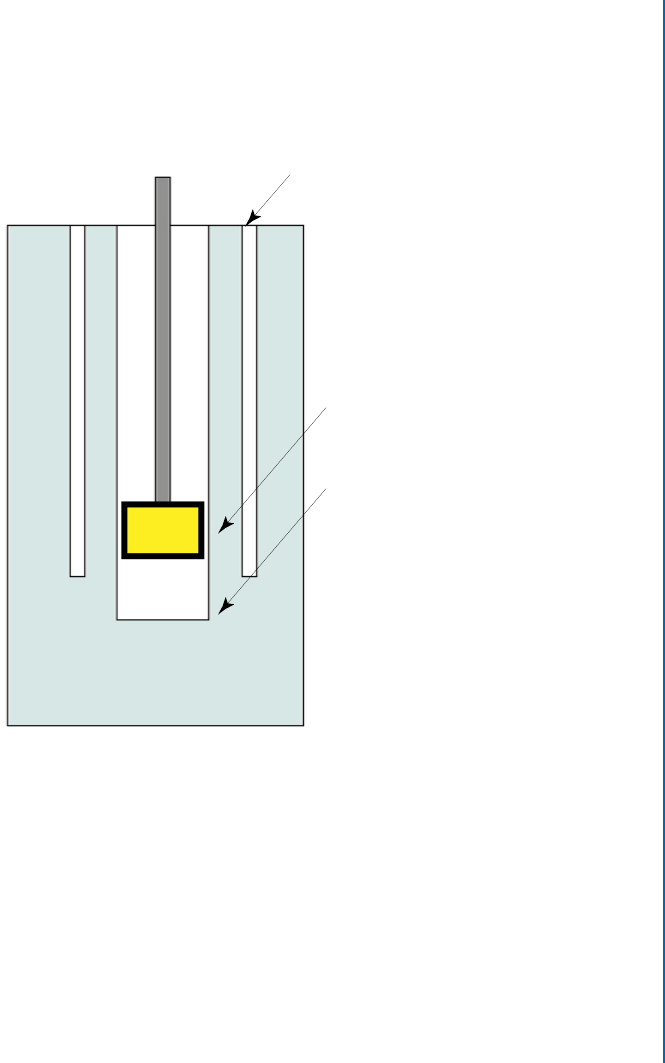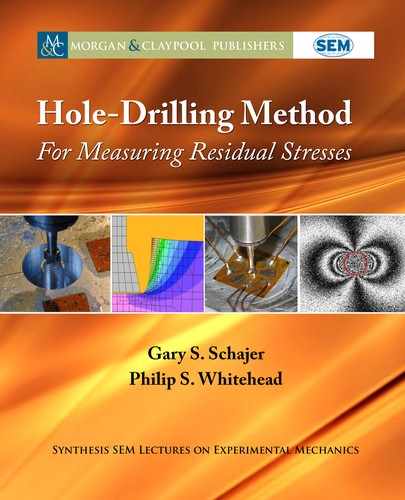32 2. RELAXATION TYPE RESIDUAL STRESS MEASUREMENT METHODS
Method is typically 20 mm, is about an order of magnitude larger than for the Hole-Drilling
Method, thereby causing correspondingly larger specimen damage.
e experimental simplicity of the Hole-Drilling Method is enhanced by the external
arrangement of the strain gauges around the hole. is means that the hole can be cut while
keeping clear of the strain gauges and their associated wiring. In contrast, the strain gauge wires
in the Ring-Core Method cross the cut path for the annular groove, thus demanding significant
operator care to avoid damaging the wires.
One area when the Ring-Core Method may be chosen over the Hole-Drilling Method is
for the measurement of residual stresses that are close to the material yield stress. e presence
of the hole creates a stress concentration that can cause local material yielding during hole-
drilling. is stress concentration exists around the outside of the hole and so affects only Hole-
Drilling measurements. By contrast, the interior of the annular groove made for Ring-Core
measurements does not have stress concentrations and so is uninfluenced. Using conventional
analytical procedures, Hole-Drilling measurements can measure residual stresses up to 80% of
yield stress. Chapter 5 describes specialized analytical procedures that can allow measurements
beyond 90% of yield stress.
e widespread use of the Hole-Drilling Method has led to the development of the
“ASTM Standard Test Method for Determining Residual Stresses by the Hole-Drilling Strain-
Gage Method, E837,” first introduced in 1985 and updated every 4–6 years. e document de-
scribes established experimental and analytical procedures for reliable residual stress evaluations.
In addition, there are also several good instruction guides prepared by strain gauge and drilling
device manufacturers as well as independent research organizations. All these support materi-
als have further encouraged the practical use and acceptance of the Hole-Drilling Method for
general residual stress measurements.
e origins of both the Hole-Drilling and Ring-Core methods derive from strain gauge
based measurements with cutting done on a mm scale. Both methods are quite flexible and they
are also conducted using many other measurement techniques, notably optical, and on scales
ranging from microscopic to major structural size. ese features are discussed in more detail in
subsequent chapters.
2.9 DEEP-HOLE METHOD
A general characteristic of relaxation type residual stress measurement methods is that they are
mostly sensitive to the stresses near the measurement location. eir sensitivity to remote stresses
rapidly diminish with distance. is effect is a consequence of the action of St. Venant’s Princi-
ple and must be taken into account when choosing or designing a residual stress measurement
method.
e Hole-Drilling and Ring-Core methods both use deformation measurements made
on the specimen surface. Consequently, they are mostly sensitive to near-surface stresses, with
rapidly diminishing sensitivity to deep interior stresses. If evaluation of deep interior stresses is

2.9. DEEP-HOLE METHOD 33
desired, it is necessary to move the deformation measurement location to the region of interest.
e Deep-Hole Method, illustrated in Figure 2.8, uses this strategy. It involves drilling an initial
reference hole, placing a sensor in the hole at the desired interior region, and making deformation
measurements, typically diameter change, as the surrounding material is separated from the bulk
material by annular over-coring.
Over-core
Diameter Sensor
Pilot Hole
Figure 2.8: Cross-section view of the Deep-Hole Method.
Measurement of diameter change in at least three directions allows evaluation of the local
perpendicular normal and shear stresses. An interesting feature of the Deep-Hole Method is
that the cutting of the initial reference hole creates a stress concentration in the surrounding
material. e subsequent over-coring relieves these locally increased stresses, not just the origi-
nally existing residual stresses. us, the Deep-Hole Method has a greater stress sensitivity than
would be expected from direct relaxation of the original residual stresses. However, the stress
concentration can also cause localized material yielding when large residual stresses, close to the
material yield stress, are present. is effect must be accounted for to get reliable results.
e Deep-Hole Method was originally introduced for geological use as a means of mea-
suring stresses within large rock masses. For this application, the reference hole can reach several
..................Content has been hidden....................
You can't read the all page of ebook, please click here login for view all page.
